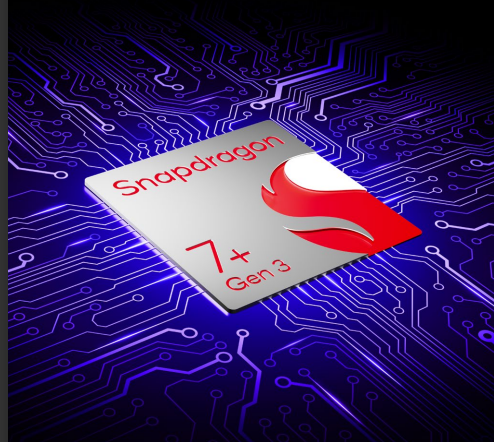Qualcomm launched its latest smartphone platform, the Snapdragon 7+ Gen 3, expanding its Snapdragon 7 series for high-end devices at a lower price point. It features on-device generative AI inference, improved CPU and GPU performance, and Wi-Fi 7 support. The platform promises enhanced entertainment experiences and a 15% CPU and 45% GPU performance increase.

What do we think? Qualcomm is continuing its push into all corners of the smartphone market, cleverly using its flagship SoC as the source for multiple versions and price points.
Qualcomm introduces the powerful Snapdragon 7+ Gen 3
Qualcomm has introduced its second and latest smartphone platform, which is an extension of its Snapdragon 7 series for high-end devices that are built to a lower price point than flagship premium smartphones.
The Snapdragon 7+ Gen 3 is, according to Qualcomm, a step up in features from the Snapdragon 7 Gen 3 introduced late last year and is billed as the most powerful Snapdragon 7 series yet.
That means it has on-device generative AI inference capabilities that the US chip and telecom biz is infusing across its smartphone platforms, as well as a boost in both CPU and GPU performance, plus Wi-Fi 7 support.
“Today, we embark on the latest expansion in the 7 series to create new levels of entertainment for consumers—integrating next-generation technologies for richer experiences,” Chris Patrick, Qualcomm’s SVP of mobile handsets, said in a canned statement.
The claimed 15% hike in CPU performance and 45% in GPU performance is relative to the Snapdragon 7+ Gen 2, released a year ago, however.
Features that Qualcomm claims to have migrated down from the top-of-the-line Snapdragon 8 series include the generative AI support, thanks to the company’s Hexagon neural processing unit (NPU), plus the triple 18-bit image signal processors to support camera functions.
Qualcomm demonstrated that phones based on its SoC could handle a 7 billion-parameter large language model (LLM). At Mobile World Congress earlier this year, the company said this platform supports models including Baichuan-7B, Llama 2, Gemini Nano, and Zhipu ChatGLM.
And if crushing to-do lists is your thing, Qualcomm claims that AI-powered virtual assistants supported by this platform will help you do that.
The Kryo CPU block inside Snapdragon 7+ Gen 3 has the 1-4-3 arrangement of one Prime core, four Performance cores, and three Efficiency cores seen in Snapdragon 8 but at lower clock speeds. Thus, the Cortex-X4 Prime is 2.8 GHz, while the other two tiers are 2.6 GHz and 1.9 GHz.
For buyers who are into their mobile games, other features added to this platform include Qualcomm’s Snapdragon Game Post Processing Accelerator and the Adreno Frame Motion Engine 2, the latter of which is claimed to enhance the frame rate without draining power.
As with the Snapdragon 8 series, the Adreno GPU on this platform can drive a 4K on-device display at up to 60 Hz and up to an 8K external display.
For connectivity, this platform has the same Snapdragon X63 5G Modem-RF System as the baseline Snapdragon 7 announced last year, which means it is capable of downlink speeds of up to 4.2 Gbps on 5G networks, rather than the 5 Gbps or 10 Gbps supported by the Snapdragon 8 series.
Wi-Fi is delivered by the same FastConnect 7800 subsystem, however, which seems to have become Qualcomm’s standard for all its smartphone platforms. This offers Wi-Fi 7, support for the 6 GHz, 5 GHz, and 2.4 GHz bands, and a peak speed of 5.8 Gbps.
Smartphone makers including OnePlus, Realme, and Sharp are expected to bring devices to market sometime in the next few months. Full specifications can be found here.